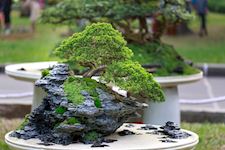Bonsai - Endorsed Certificate Course (TQUK - Training Qualifications UK)
Distance learning course with study materials, tutor support and final exam included
Academy For Distance Learning
Summary
- Certificate of completion - Free
- Exam(s) / assessment(s) is included in price
- Tutor is available to students
Add to basket or enquire
Overview
Bonsai Online Course. 100 Hours Endorsed Certificate Course (TQUK - Training Qualifications UK).
Bonsai course online. Master Bonsai keeping! Join the many who have learnt the ancient oriental art of bonsai through this practical and comprehensive course. Eight lessons cover the selection of plants suited to bonsai, understanding the history and classic shapes which form the basis of the art, techniques of planting, training, pruning, watering & feeding and ways of using bonsai both indoors and outdoors. Create several bonsai of your own during the course.
Benefits of an ADL Endorsed Course?
Endorsed courses are skills based. They have been evaluated and approved by an independent awarding body such as Training Qualifications UK (TQUK).
What makes ADL’s Endorsed courses different?
- Flexible Self-Paced Learning– adjust your learning around your home and work commitments
- Start and Finish at any time
- Courses globally and industry relevant
- Practical Component at the end of most lessons.
Allocated your own tutor relevant to your subject. You can have as little or as much contact as you like with your tutor. They are there to support you all the way through.
This course is endorsed by TQUK -Training Qualifications UK, an OFQUAL awarding body.
Achievement
Course media
Description
Lesson Structure: Bonsai BHT320
There are 8 lessons:
- Introduction
- Plant Taxonomy Botanical/Horticultural Nomenclature, The Binomial System, Botanical Classification, Plant Families and Species, Hybrids, Varieties and Cultivars
- Pronunciation of Plant Names
- Groups of Plants
- Resources reference books, organisations, magazines and journals, nurseries, bonsai shops, seed suppliers and the internet.
- Propagation
- Introduction
- Methods of Propagating Plants sexual propagation, asexual propagation
- Seed Propagation collecting seed, storing seed and sowing seed
- Cutting Propagation stem cuttings, hardwood cuttings, semi-hardwood cuttings, leaf cuttings, leaf bud cuttings, root cuttings, factors affecting rooting of cuttings, striking cuttings, after care.
- Propagating Mixes and potting mixes
- Other Propagation Methods layering, air layering and grafting.
- Plants for Bonsai
- Introduction
- History of Bonsai
- Types of plants suited for use as Bonsai sourcing Bonsai material
- Some plant choices
- Bonsai Styles and Techniques
- Classification of styles of Bonsai eg. formal upright, informal upright, slanting or leaning, semi cascade, cascade
- Other styles of classification eg. sakei
- Japanese classification
- Bonsai Techniques
- Bonsai Containers preparing the container
- Wire wiring a bonsai
- Pruning
- Tools needed for Bonsai work pruning tools, potting tools and wiring tools.
- Creating Bonsai
- Principles of Design roots, trunk and branches.
- Evaluating the Bonsai and assessing additional features
- Pruning and shaping the bonsai plant prune and grow techniques
- Wiring wiring techniques and grooming
- Branch Patterns in Bonsai jins, shari and driftwood
- Root Evaluation in the Initial Stages of Bonsai potting the Bonsai, rock planting, clasped to rock design and root over rock.
- Bonsai Culture and Maintenance
- Soils Soil composition, colloids, structure, texture, chemical properties, improving soils, improving texture, improving structure, improving fertility.
- Soil for potted bonsai principle components
- Particle characteristics particle size, sorting, particle shape, particle surface texture
- Growing Medium Mixture functions of a growing medium, properties of a growing medium, drainage, water retention and colour and appearance.
- The Nutrient Elements macronutrients and micronutrients
- Common Pest Problems on Bonsai eg. aphids, borers, caterpillars, scale and thrips.
- Common Fungal Diseases of Plants eg. Anthracnose, Powdery Mildew and Rust
- Watering and Fertilising Bonsai symptoms of water deficiency, symptoms of excess water and fertilising.
- Repotting and Root Pruning the Bonsai
- Maintenance Pruning for Bonsai removing dead/diseased wood, controlling the type of growth, controlling shape and size, rejuvenating, leaf cutting, basic rules of pruning, points to consider when pruning.
- Placing the Bonsai
- Landscaping Principles for Bonsai
- Principles of Landscape Design Unity, Balance, Proportion, Harmony, Contrast and Rhythm
- Qualities of Landscape Components line, form, mass, space, texture, colour and tone
- Creating Landscape Effects
- Landscape Applications for Using Bonsai group plantings, ssaikei, bonseki, bonkei, miniature gardens, rock gardens, water gardens.
- Bonsai in Tubs and Landscape Features
- Special Assignment
- Research a particular aspect of bonsai of interest.
Who is this course for?
Bonsai Enthusiasts, Garden Designers, Horticulturalists, Landscapers
Requirements
A pc or laptop with internet connection.
Career path
Interested in becoming a Bonsai Culturist? Well, enrolling on this exciting TQUK Endorsed Course could be the first step in that journey. Successful bonsai culturists are artists in their own right because they capture the feel of a tree and shape it accordingly.
Questions and answers
Currently there are no Q&As for this course. Be the first to ask a question.
Certificates
Certificate of completion
Digital certificate - Included
Reviews
Currently there are no reviews for this course. Be the first to leave a review.
Legal information
This course is advertised on reed.co.uk by the Course Provider, whose terms and conditions apply. Purchases are made directly from the Course Provider, and as such, content and materials are supplied by the Course Provider directly. Reed is acting as agent and not reseller in relation to this course. Reed's only responsibility is to facilitate your payment for the course. It is your responsibility to review and agree to the Course Provider's terms and conditions and satisfy yourself as to the suitability of the course you intend to purchase. Reed will not have any responsibility for the content of the course and/or associated materials.





